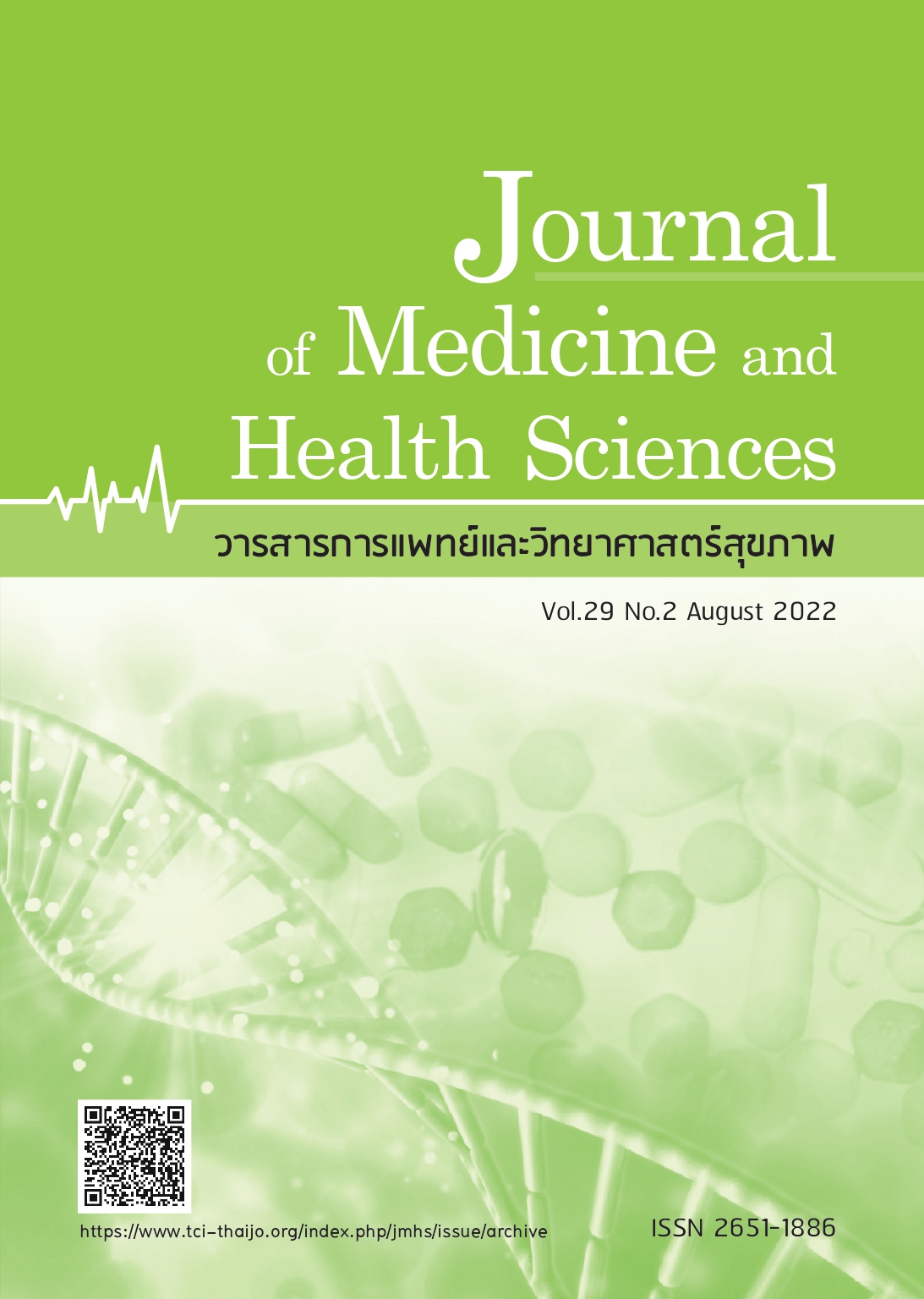ฤทธิ์ปกป้องเซลล์ประสาทของน้ำมันแฝกหอมต่อการตายของเซลล์จากฮอร์โมน คอรติโคสเตอโรนในเซลล์ประสาท neuroblastoma SH-SY5Y cells ผ่านกลไกการต้านอนุมูลอิสระ
คำสำคัญ:
ภาวะซึมเศร้า, น้ำมันแฝกหอม caspase-3, แลคเตทดีไฮโดรจีเนส, การมีชีวิตรอดของเซลล์, การต้านอนุมูลอิสระบทคัดย่อ
บทคัดย่อ
น้ำมันแฝกหอมมีคุณสมบัติในการลดความเครียดและภาวะซึมเศร้าได้ พยาธิสรีรวิทยาของภาวะซึมเศร้าเกิดจากความเสียหายของระบบประสาทที่มีสาเหตุหลายประการ โดยเฉพาะอย่างยิ่งจากอนุมูลอิสระที่เพิ่มขึ้น ดังนั้นการศึกษาครั้งนี้จึงมีวัตถุประสงค์เพื่อตรวจสอบฤทธิ์ต้านอนุมูลอิสระของน้ำมันแฝกหอมต่อการตาย neuroblastoma SH-SY5Y จากพิษของคอร์ติโคสเตอโรน โดยเลี้ยงเซลล์ด้วยคอร์ติโคสเตอโรน 650 μM ร่วมกับน้ำมันแฝกหอม (0.025, 0.05, 0.1, 0.25, 0.5, 1, 1.5, 2.5, 5 µg/ml) หรือ fluoxetine 10 μM เป็นเวลา 24 ชั่วโมง แล้วศึกษาความอยู่รอดของเซลล์โดยการวิเคราะห์ด้วย MTT และ lactate dehydrogenase (LDH) โดยเทคนิค spectrometry และฤทธิ์ต้านอนุมูลอิสระโดยการวัด caspase-3 และ reactive oxygen species (ROS) โดยเทคนิค ELISA จากการศึกษาพบว่าน้ำมันแฝกหอม (0.1 µg/ml) ทำให้เซลล์รอดชีวิตมากกว่าการเลี้ยงเซลล์ด้วย corticosterone เพียงอย่างเดียว เมื่อเลี้ยงเซลล์ด้วย corticosterone จะทำให้การหลั่ง LDH เพิ่มขึ้น ในขณะที่น้ำมันแฝกหอมความเข้มข้น 0.025, 0.05, 0.5, 0.1, 0.25 และ 0.5 µg/ml และ fluoxetine 10 μMสามารถยับยั้งการเพิ่มการหลั่ง LDH เนื่องจากพิษต่อเซลล์จากการได้รับ corticosterone ที่น่าสนใจคือ corticosterone เพิ่ม caspase-3 อย่างมีนัยสำคัญ ในทางตรงข้ามพบว่าน้ำมันแฝกหอม 0.5 µg/ml ช่วยบรรเทาการเพิ่มของ caspase-3 จากการได้รับ corticosterone ในขณะที่ fluoxetine ไม่มีผลดังกล่าว นอกจากนี้พบว่าน้ำมันแฝกหอม 0.025, 0.05, 0.5, 0.1, 0.25, 0.5 µg/ml และ fluoxetine ยับยั้ง ROS ภายในเซลล์ที่เพิ่มจากการได้รับคอร์ติโคสเตอโรน ดังนั้นการศึกษาครั้งนี้แสดงให้เห็นว่าน้ำมันแฝกหอมมีฤทธิ์ปกป้องเซลล์ประสาท น่ามาผ่านกลไกในการต้านอนุมูลอิสระ
References
Qin DD, Rizak J, Feng XL, et al. Prolonged secretion of cortisol as a possible mechanism underlying stress and depressive behaviour. Sci Rep
;6:30187.
Ferguson JM. SSRI antidepressant medications: Adverse effects and tolerability. Prim Care Companion J Clin Psychiatry 2001;3:22-7.
Perry N, Perry E. Aromatherapy in the management of psychiatric disorders:Clinical and neuropharmacological perspectives. CNS Drugs 2006;20:257-80.
Santarsieri D, Schwartz TL. Antidepressant efficacy and side-effect burden: a quick guide for clinicians. Drugs Context 2015;4:212290.
Sánchez-Vidaña DI, Ngai SPC, He W, et al. The effectiveness of aromatherapy for depressive symptoms: A systematic review. Evid Based Complement Alternat Med 2017;2017:5869315.
Rafii F, Ameri F, Haghani H, et al. The effect of aromatherapy massage with lavender and chamomile oil on anxiety and sleep quality of patients with burns. Burns 2020;46:164-71.
Fung JKKM, Tsang HWH. Management of behavioural and psychological symptoms of dementia by an aroma-massage with acupressure treatment protocol: A randomised clinical trial. J ClinNurs 2018; 27:1812-25.
Ebrahimi H, Mardani A, Basirinezhad MH, et al. The effects of Lavender and Chamomile essential oil inhalation aromatherapy on depression, anxiety and stress in older community-dwelling people: A randomized controlled trial. Explore (NY) 2022;18:272-8.
Chaiyasut C, Sivamaruthi BS, Wongwan J, et al. Effects of Litseacubeba (Lour.) Persoon essential oil aromatherapy on mood states and salivary cortisol levels in healthy volunteers. Evid Based Complement Alternat Med 2020;2020:4389239.
Faturi CB, Leite JR, Alves PB, et al. Anxiolytic-like effect of sweet orange aroma in Wistar rats. Prog Neuropsychopharmacol Biol Psychiatry 2010;34:605-9.
Saiyudthong S, Pongmayteegul S, Marsden CA, et al. Anxiety-like behaviour and c-fos expression in rats that inhaled vetiver essential oil. Nat Prod Res 2015;29:2141-4.
Saiyudthong S, Srijittapong D, Mekseepralard C. Subchronic administration of linalool decreases depressive-like behaviour in restrained rats. J Pharm Pharmacol 2017;5:401-7.
Ogata K, Ataka K, Suzuki H, et al. Lavender oil reduces depressive mood in healthy individuals and enhances the activity of single oxytocin neurons of the hypothalamus isolated from mice: A preliminary study. Evid Based Complement Alternat Med
;2020:5418586.
Mohankumar A, Kalaiselvi D, Levenson C, et al. Antioxidant and stress modulatory efficacy of essential oil extracted from plantation-grown Santalum album L. Ind Crops Prod 2019;140:111623.
Aboul-Fotouh S. Coenzyme Q10 displays antidepressant-like activity with reduction of hippocampal oxidative/nitrosative DNA damage in chronically stressed rats. Pharmacol Biochem Behav 2013;104:105-12.
Ali B, Al-Wabel NA, Shams S, et al. Essential oils used in aromatherapy: A systemic review. Asian Pac J Trop Biomed 2015;5:601-11
Gupta D, Radhakrishnan M, Kurhe Y. Effect of a novel 5-HT3 receptor antagonist 4i, in corticosterone-induced depression-like
behavior and oxidative stress in mice.Steroids 2015;96:95-102.
Subhadradevi V, Asokkumar K, Umamaheswari M, et al. In vitro antioxidant activity of Vetiveriazizanioides root extract. Tanzan Health Res Bull 2010;12:1-7.
Luqman S, Kumar R, Kaushik S, et al.Antioxidant potential of the root of Vetiveriazizanioides (L.) Nash. Indian J Biochem Biophys 2009;46:122-5.
Jantas D. Cell-based systems of depression: An overview. In: Herbal medicine in depression. Springer International Publishing;2016:75-117.
Zhang F, Shao J, Tian J, et al. Antidepressantlike effects of LPM580153, A novel potent triple reuptake inhibitor. Sci Rep 2016;6:24233.
Kumar P, Nagarajan A, Uchil PD. Analysis of cell viability by the lactate dehydrogenase assay. Cold Spring Harb Protoc 2018;2018:095497.
Yu Z, Kong D, Liang Y, et al. Protective effects of VMY-2-95 on corticosteroneinduced injuries in mice and cellular models. Acta Pharm Sin B 2021;11:1903-13.
Zhang H, Liu B, Wu J, et al. Icariin inhibits corticosterone-induced apoptosis in hypothalamic neurons via the PI3-K/Akt signaling pathway. Mol Med Rep 2012;6:967-72.
Ziru Yu Z, Kong D, Liang Y, et al. Protective effects of VMY-2-95 on corticosteroneinduced injuries in mice and cellular models. Acta Pharmaceutica Sinica B 2021;11:1903e1913.
Hwang S, Kim JK. Fluoxetine induces apoptotic and oxidative neuronal death associated with the influx of copper ions in cultured neuronal cells. Chonnam Med J 2020;56:20-6.
Kim HJ, Chen F, Wang X, et al. Evaluation of antioxidant activity of vetiver (Vetiveria zizanioides L.) oil and identification of its antioxidant constituents. J Agric Food Chem 2005;53:7691-5.
Downloads
เผยแพร่แล้ว
How to Cite
ฉบับ
บท
License

This work is licensed under a Creative Commons Attribution-NonCommercial-NoDerivatives 4.0 International License.





